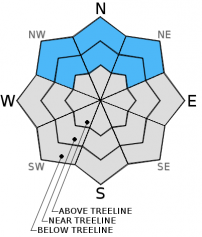| Sunday | Sunday Night | Monday | |
|---|---|---|---|
| Weather: | Sunny | Clear with some clouds developing overnight | Partly cloudy becoming mostly cloudy during the day |
| Temperatures: | 37 to 44 deg. F. | 22 to 32 deg. F. | 40 to 47 deg. F. |
| Mid Slope Winds: | East | Variable | Southwest |
| Wind Speed: | 5 to 15 mph | Light | 5 to 10 mph |
| Expected snowfall: | 0 | 0 | 0 |
| Sunday | Sunday Night | Monday | |
|---|---|---|---|
| Weather: | Sunny | Clear with some clouds developing overnight | Partly cloudy becoming mostly cloudy during the day |
| Temperatures: | 30 to 40 deg. F. | 22 to 32 deg. F. | 32 to 42 deg. F. |
| Ridge Top Winds: | East | Variable | Southwest |
| Wind Speed: | 10 to 15 mph | Light | 10 to 15 mph with gusts to 25 mph in the afternoon |
| Expected snowfall: | 0 | 0 | 0 |

























